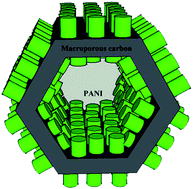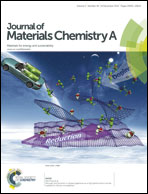Aligned polyaniline nanowires grown on the internal surface of macroporous carbon for supercapacitors†
Abstract
High utilization efficiency of electrode materials is of great importance for achieving excellent electrochemical performance of supercapacitors. In this paper, we report the growth of aligned polyaniline (PANI) nanowires on the internal surface of macroporous carbon (MC) derived from luffa sponge fibers for increasing their utilization efficiency. The pores in the MC are densely packed, straight, and parallel with the diameter at the micrometer scale, which provide easy paths for reaction solution to penetrate and thus enable the growth of the PANI nanowires on the internal wall surface. Due to full exposure to the electrolyte, the PANI nanowires exhibit high utilization efficiency, leading to high specific capacitance up to 1500 F g−1 (1 A g−1). As the macropores allow easy penetration of the electrolyte, the PANI nanowires show high rate capability with the capacitance retention up to 70% with increasing current density from 1 to 10 A g−1. Symmetric supercapacitors assembled using the MC/PANI materials possess high energy density (19 W h kg−1 at 0.5 kW kg−1) and long cycle life (83% retention after 7000 cycles). Considering the abundance and green production of the luffa sponge the MC/PANI composites are promising for industrial application of supercapacitors.


 Please wait while we load your content...
Please wait while we load your content...